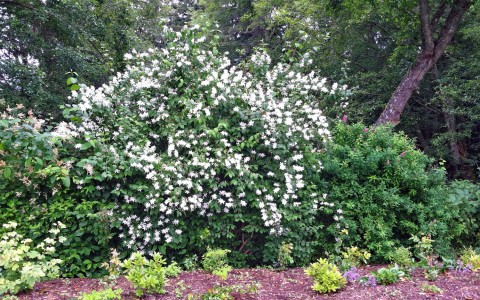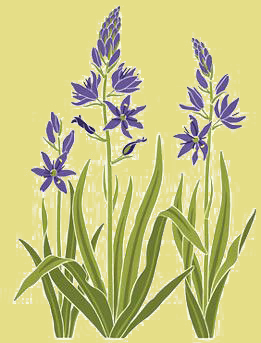Native Plant Hedgerows - Beauty, Function and Habitat

Once out of favor, hedgerows are enjoying a resurgence in popularity in modern landscaping. Planted with native plants, they can be beautiful, functional and also attract wildlife by providing food and habitat.
Farmers have historically planted hedgerows that served multiple functions such as erosion control, wind break and livestock fencing, among others. In today's gardens, hedgerows are a great way to create a dense barrier for privacy, designate property boundaries, hide unsightly views or reduce noise pollution. Instead of erecting a fence, planting a boring row of arborvitae or a single-shrub hedge that needs constant trimming, why not think about planting a living fence with a mix of natives; trees, shrubs and herbaceous plants. You can create an "edge of the forest" look with a planting that will attract birds, small mammals, beneficial insects and pollinators. If you particularly enjoy birding, consider investigating your favorite birds' eating and nesting needs and include an abundance of those plants in your hedgerow. The more species of native plants that are included, the more diverse the population of animals utilizing the area.
To provide for the widest variety of wildlife, hedgerows should have assorted layers of vegetation such as canopy trees, understory trees, shrubs of various heights and groundcovers. You will need an area at least 10 feet wide; but if you are truly interested in attracting wildlife and providing habitat, 20 feet wide would be even better. You can actually make your hedgerow as wide and long as you need. Plant larger deciduous and evergreen trees and shrubs in the back of the hedgerow and smaller trees and shrubs in front of them. Work inward, layering your plants from tallest to shortest. With some planning, your hedgerow can showcase beautiful flowers in the spring and summer, attracting bees, butterflies and hummingbirds. For late summer and fall interest, use plants that have colorful foliage and berries. The berries of native plants are an important food source for many birds and mammals. Add a lower layer of ferns, grasses, perennials or bulbs in the front for additional color and texture.
Prepare your hedgerow site by removing existing non-native vegetation. If you have native plants growing in the area, particularly canopy trees, such as firs and cedars, try to incorporate them into your hedgerow design. You may want to till in some compost or top dress the area with compost and let nature do the work. Give your trees and shrubs at least 75% of the growing space normally required, so your plantings knit together to form a barrier, but don't choke each other out. You may have to undertake some weed suppression. Unfortunately, when birds and mammals use your hedgerow, they may bring the seeds of noxious weeds they eat elsewhere and deposit them in your hedge. Watch for blackberries, English ivy, English holly, cotoneaster and other invasives and remove them before they really take hold. Because native plants are adapted to the area, they will be hardy and require less care than non-native ornamentals. In fact, in order to avoid interfering with nesting birds and mammals, you will want to disturb the hedgerow as little as possible. In the wild these plants will establish themselves without it, but if you can provide your plantings with supplemental water during long dry periods for the first year or two, it will help them thrive. After that period, they should survive just fine on their own.
Planting a hedgerow doesn't have to be a daunting task, because it doesn't have to be planted all at once. In fact, planting it over a period of several years will give you time to choose the right plants and observe how their colors, textures and shapes work together. Take the time to research the native plants for your area and select the ones best suited to your site. Pay attention to what kind of growing conditions the various plants need. A large hedgerow may have shady areas and sunny areas; wet ones and dry ones; choose and place your plants accordingly. Remember to keep in mind the ultimate size of the trees and shrubs you are planting.
In the Buck Lake Native Plant Garden, we have planted a hedgerow at the south end of the garden. It hides an unsightly ravine filled with fallen alder trees, blackberries and nettles and provides a backdrop for other plantings in the garden. Vine maple, mock orange, Douglas spirea and black twinberry are some of the plants we have used. Our Plant Profiles contain information about these and other plants suitable for hedgerow planting. In addition to our planted hedgerow, the north end of the garden is bordered by a natural hedgerow of native and non-native plants surrounding a mowed meadow.
Image Credits
Lindsey Vallance

